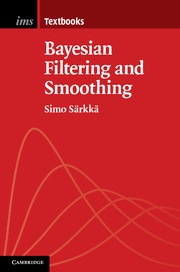Book contents
- Frontmatter
- Contents
- Preface
- Symbols and abbreviations
- 1 What are Bayesian filtering and smoothing?
- 2 Bayesian inference
- 3 Batch and recursive Bayesian estimation
- 4 Bayesian filtering equations and exact solutions
- 5 Extended and unscented Kalman filtering
- 6 General Gaussion filtering
- 7 Particle filtering
- 8 Bayesian smoothing equations and exact solutions
- 9 Extended and unscented smoothing
- 10 General Gaussian smoothing
- 11 Particle smoothing
- 12 Parameter estimation
- 13 Epilogue
- Appendix Additional material
- References
- Index
2 - Bayesian inference
Published online by Cambridge University Press: 05 June 2014
- Frontmatter
- Contents
- Preface
- Symbols and abbreviations
- 1 What are Bayesian filtering and smoothing?
- 2 Bayesian inference
- 3 Batch and recursive Bayesian estimation
- 4 Bayesian filtering equations and exact solutions
- 5 Extended and unscented Kalman filtering
- 6 General Gaussion filtering
- 7 Particle filtering
- 8 Bayesian smoothing equations and exact solutions
- 9 Extended and unscented smoothing
- 10 General Gaussian smoothing
- 11 Particle smoothing
- 12 Parameter estimation
- 13 Epilogue
- Appendix Additional material
- References
- Index
Summary
This chapter provides a brief presentation of the philosophical and math¬ematical foundations of Bayesian inference. The connections to classical statistical inference are also briefly discussed.
Philosophy of Bayesian inference
The purpose of Bayesian inference (Bernardo and Smith, 1994; Gelman et al., 2004) is to provide a mathematical machinery that can be used for modeling systems, where the uncertainties of the system are taken into account and the decisions are made according to rational principles. The tools of this machinery are the probability distributions and the rules of probability calculus.
If we compare the so-called frequentist philosophy of statistical analysis to Bayesian inference the difference is that in Bayesian inference the prob¬ability of an event does not mean the proportion of the event in an infinite number of trials, but the uncertainty of the event in a single trial. Because models in Bayesian inference are formulated in terms of probability dis¬tributions, the probability axioms and computation rules of the probability theory (see, e.g., Shiryaev, 1996) also apply in Bayesian inference.
Connection to maximum likelihood estimation
Consider a situation where we know the conditional distribution p(yk | θ) of conditionally independent random variables (measurements) y1:T = {y1,…, yT}, but the parameter θ ∊ ℝd is unknown.
- Type
- Chapter
- Information
- Bayesian Filtering and Smoothing , pp. 17 - 26Publisher: Cambridge University PressPrint publication year: 2013
- 1
- Cited by

